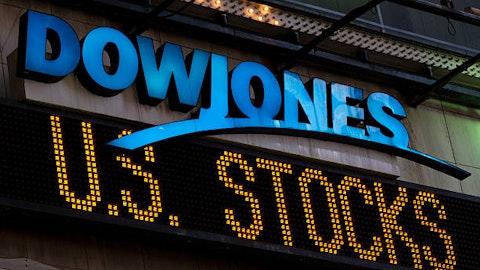The Coca-Cola Company (NYSE:KO) Q4 2023 Earnings Call Transcript February 13, 2024
The Coca-Cola Company beats earnings expectations. Reported EPS is $0.49, expectations were $0.48. The Coca-Cola Company isn’t one of the 30 most popular stocks among hedge funds at the end of the third quarter (see the details here).
Operator: At this time, I’d like to welcome everyone to the Coca-Cola Company’s Fourth Quarter 2023 Earnings Results Conference Call. Today’s call is being recorded. If you have any objections, please disconnect at this time. All participants will be on listen-only mode until the formal question-and-answer portion of the call. I would like to remind everyone that the purpose of this conference is to talk with investors and therefore, questions from the media will not be addressed. Media participants should contact Coca-Cola’s Media Relations Department if they have any questions. I would now like to introduce Ms. Robin Halpern, Vice President and Head of Investor Relations. Ms. Halpern, you may now begin.
Robin Halpern: Good morning, and thank you for joining us. I’m here with James Quincey, our Chairman and Chief Executive Officer; and John Murphy, our President and Chief Financial Officer. We’ve posted schedules under financial information in the Investors section of our company website. These reconcile certain non-GAAP financial measures that may be referred to this morning to results as reported under generally accepted accounting principles. You can also find schedules in the same section of our website that provide an analysis of our growth and operating margin. This call may contain forward-looking statements, including statements concerning long-term earnings objectives which should be considered in conjunction with cautionary statements contained in our earnings release and in the company’s periodic SEC reports.
Following prepared remarks, we will take your questions. Please limit yourself to one question. Re-enter the queue to ask any follow-up. Now, I will turn the call over to James.
James Quincey: Thanks, Robin. And good morning, everyone. In 2023, we achieved our near-term goals, while also positioning our business for the long-term. Our all-weather strategy delivered 8% comparable earnings per share growth despite greater than expected 7% currency headwinds. Today, we are leveraging our scale globally and winning locally, which gives us confidence that we can deliver on our 2024 guidance. This morning, I’ll talk about the global consumer landscape, then I’ll highlight how our strategy and enhanced capabilities are making us a more agile and effective organization. And finally, John will discuss our financial results and our 2024 guidance. During the quarter, we benefited from strong performance across many of our markets.
However, some were impacted by elevated inflation and others by geopolitical tensions and conflict. We delivered 12% organic revenue growth, which included 2 points of volume growth, continuing a positive volume trend for the year. Throughout, we continue to invest in our business to provide the right portfolio of brands and packages to retain and attract more drinkers. We drove industry growth and delivered value share gains in the quarter and for the full year. We achieved these results by effectively navigating a number of headwinds and capitalizing on tailwinds across our markets. During the quarter, we saw strong consumer demand across Australia, India, Latin America, Japan and South Korea. In North America, consumer spending in aggregate is holding up well.
And in Europe, consumers remain cost conscious. In Africa and China, the macro environment remains uncertain. And in the Middle East, tensions have resulted in some shapes in consumer behavior that have had an impact on our business. Another important fact that I highlight is the inflationary pressures, which are moderating or stabilizing across most of our markets. To keep consumers in our franchise, we are leveraging our revenue growth management capabilities to tailor our offerings and price pack architecture to meet consumers’ evolving needs. In North America and Europe, while inflation is moderating, the cumulative impact of inflation is pressuring certain consumer segments we’re seeking value. Throughout 2023, we increased our affordability offerings and one volume and value share in both regions.
In Latin America, despite double digit inflation during the fourth quarter, we grew volume 4% and increased household penetration and basket initiatives. There are a few pockets of the world that are experiencing hyperinflation. John will later speak to how this dynamic is impacting our business. However, I did want to mention that our local franchise operating model allows us to navigate through hyperinflationary environment and then gain an advantage over the long-term. Across our business, we continue to prioritize agility and focus on improving every aspect of how we operate. An important part of this is our marketing transformation. To recruit the next generation of drinkers, our marketing has shifted from a TV centric model to a digital first organization that balances local intimacy, scale and flexibility.
Our digital mix has gone from less than 30% in 2019 to approximately 60% of our total media spend. In 2023, we stood up Studio X, the digital ecosystem that brings this altogether. We created physical hubs in each of our operating units to integrate disciplines, standardized data and technology and step change our capabilities. Creative, media, social and production capabilities and now operating at scale connected by our global network structure. In our previous model, it took several months to create a TV ad. Now, we’re producing thousands of pieces of digital content that are contextually relevant and measuring these results in real-time. Studio X is driving tangible results. For example, Coke Studio which originated in Pakistan and taps into consumers’ passion for music has been scale to our top 40 markets.
The campaign uses packaging as digital portals to access real magic experiences, which have generated more than 1.2 billion YouTube views and a 100 million music streams this year, resulting in strong recruitment of Gen Z drinkers. We’re engaging differently with consumers and is delivering results. In 2023, according to Cantor, Coca-Cola brand value increased $8 billion. Coke is now the 10th most valuable brand in the world, up seven spots from the prior year. In the US, Sprite was named by Morning Consult as the number one beverage brands for Gen Z drinkers. We were also named one of the top 10 innovative companies in augmented and virtual reality by Fast Company. Our innovation agenda is increasing our competitive advantage across our products, packaging and equipment.
Taste is the starting point. Simply put, people want drinks to taste great. To drive superiority across our total beverage portfolio, we’re continuing to build capabilities to tap into unique insights in taste and aroma sciences. We’re applying digital tools, ingredient processing technology and AI to create bolder and more successful innovations. Coca-Cola Zero Sugar is an ongoing example of how superior taste drives demand, with volume that grew 5% in 2023, leading to continued volume and value share gains. We are applying learnings from this multiyear success and driving taste superiority elsewhere in our sparkling portfolio. In 2023, we launched Sprite and Fanta reformulations in 25 markets, delivering mid-single digit volume growth in those markets and driving overall sparkling flavors value share gains.
Outside of our sparkling portfolio, we’re dialing up flavor profiles, adding functional benefits and expanding into new categories. In Japan, we relaunched Georgia Coffee, which generated broader customer interest and led to value share gains. In the US, fairlife’s Core Power and nutrition plan of a high protein dairy without compromising taste. In 2023, fairlife grew volume 15%, its 9th consecutive year of double digit volume growth. We’re also seeing continued promising results from FUZE Tea across Europe, Jack and Coke in the Philippines, Flashlight in Mexico, among many others. In 2023, innovation contributed to approximately 30% of gross profit growth and our success rates have nearly tripled compared to 2019 levels. Our revenue growth management execution capabilities continue to be distinct advantages.
As demonstrated by our ability to deliver volume and transaction growth, despite ongoing inflationary pressures. We’re working with our bottling partners to capture every opportunity available to create significant value for consumers and customers. By offering a total beverage portfolio in the right packages and at the right price points, we’re driving category expansion and becoming more relevant to more consumers and customers. In North America, we’re evolving packaging options across more distribution points, drive affordability and premiumization. On the affordability side, our 1.25 liter PET bottles are now available in 80% of supermarkets and our 16 ounce can distribution increased by 14 points in convenience stores during 2023. We’re also focused on premiumization through the expansion of our mini can offerings.
During the quarter, we launched 15 pack mini cans in grocery and club channels. In Europe, we’re leveraging the same playbook, but adapting it to local needs. In Spain, our 1.25 liter PET package is offered at a compelling price point and it drove 16% volume growth and increased household penetration in 2023. In Italy, Britain and Ireland, we drove premium single serve mini cans, a smaller package offerings to generate positive mix and incremental retail sales. Our franchise system uniquely combines the benefits of scale and knowledge sharing with the know-how needed to execute for customers and win locally in many different operating environments. For example, approximately 70% of purchase decisions are influenced at point of sale, our systems stepped up in-store displays during the quarter which drove incremental retail sales and cross selling opportunities.

Putting it all together, we created $15 billion in incremental retail sales for our customers in 2023, more than any other beverage company. This was our sixth year in a row as the leader in value creation. While we’re pleased with our progress, we recognize there’s still much work to be done to capture the vast opportunities available. Our system is galvanized to move further and faster. Before I hand over to John, I want to acknowledge that none of this could happen without the unwavering dedication of our employees. And so as we turn to 2024, we expect the year will bring new challenges and opportunities. And we’ll remain ready to respond through continuing to improve execution of our strategy across our total beverage portfolio. I look forward to sharing more next Tuesday at CAGNY and I encourage everyone to listen in.
With that, I will turn the call over to John.
John Murphy: Thank you, James. And good morning, everyone. In the fourth quarter and throughout 2023, we delivered strong results. During the quarter, we grew organic revenues 12% which was in-line with our full year organic revenue growth. Unit case growth was 2% and it was positive in each quarter of 2023. Concentrate sales grew 1 point ahead of unit cases, driven primarily by one additional day in the quarter. Our price mix growth of 9% in the quarter was driven by three factors. One, 2023 pricing actions across most of our markets. Two, hyperinflationary pricing that I’ll speak to in just a moment. And three, some mix which is mostly timing related. Comparable gross margin for the quarter was up approximately 140 basis points.
Driven by underlying expansion and a slight benefit from bottle refranchising. Partially offset by the impact of currency headwinds. Comparable operating margin expanded approximately 40 basis points for the quarter. This was primarily driven by strong topline growth, partially offset by currency headwinds and an increase in marketing investments. The positive volume and topline growth that we’re realizing today demonstrates the effectiveness of our marketing spend. Below the line, comparable other income declined primarily due to the operating environment in Argentina. Putting it all together, fourth quarter comparable EPS of $0.49 was up 10% year-over-year, despite higher than expected 13% currency headwinds. Before moving on, I wanted to discuss the impact of a few hyperinflationary markets on our fourth quarter results.
During the quarter, inflation intensified and exceeded 60% across these markets. In aggregate, while they represent less than 5% of our total volume, this degree of inflation creates a cosmetic distortion to our underlying results. In the fourth quarter, these markets contributed more than 3 points of our price mix and most of our currency headwinds, including an outsized impact to comparable other income from balance sheet remeasurement in Argentina. They did not, however, have a material impact on our earnings per share results. In hyperinflationary markets it’s either impractical or impossible to hedge our currency exposure. And to manage it, we use our full suite of revenue growth management tools, including pricing actions to keep pace with local market inflation.
We have been operating a long-time in these markets and we expect to be in them for a long-time to come. We work hand-in-hand with our local bottling partners and our focus will be to continue to nurture the strong relationships we have with our consumers and customers. And to ultimately prevail longer-term. So while we will continue to experience volatility of this nature in a few markets, it’s important to keep in mind they are operated locally, they are typically self-funding and they have not impeded our overall ability to grow earnings per share. As we move forward, we are confident that our business model and the many levers within it will allow us to deliver on our overall objectives. In 2023 free cash flow was $9.7 billion, which increased from the prior year.
2023 free cash flow included a transition tax payment of approximately $720 million, which was approximately $340 million higher than the prior year and included approximately $230 million in M&A related payments. Our underlying free cash flow growth was largely attributable to strong operational performance and working capital benefits. If you exclude the full impact of the transition tax in M&A related payments, our adjusted free cash flow conversion ratio would be within our target range of 90% to 95%. Our balance sheet remains strong. And our net debt leverage of 1.7 times EBITDA is below our targeted range of 2 times to 2.5 times. During the fourth quarter, in addition to offsetting dilution from the exercise of stock options by employees, we repurchased additional shares in anticipation of expected proceeds from bottler refranchising.
As James mentioned, we anticipate 2024 will bring new challenges and opportunities. However, through our all-weather strategy, we’ve proven we can deliver in many different operating environments. Our 2024 guidance builds on the underlying momentum of our business. We expect organic revenue growth of 6% to 7% and comparable currency neutral earnings per share growth of 8% to 10%. We anticipate hyperinflationary pricing will continue to play a role in 2024, but it will moderate throughout the year. We continue to make significant progress towards refranchising company owned bottling operations. Bottler refranchising is expected to be a 4 point to 5 point headwind to comparable net revenues and a 2 point headwind to comparable earnings per share.
But will have a positive impact on both our margins and the return profile of our business. Based on current rates and our hedge positions, we anticipate an approximate 2 point to 3 point currency headwind to comparable net revenues and an approximate 4 point to 5 point currency headwind to comparable earnings per share for full year 2024. Notably, much of our anticipated 2024 currency headwinds are attributed to hyperinflationary markets with a meaningful impact in the fourth quarter. Our underlying effective tax rate for 2024 is expected to be 19.2%. All in, we expect comparable earnings per share growth of 4% to 5% versus $2.69 in 2023. We expect to generate approximately $9.2 billion of free cash flow in 2024 through approximately $11.4 billion in cash from operations, less approximately $2.2 billion in capital investments.
The $11.4 billion of cash from operations includes two items to highlight, transition tax payments of approximately $960 million, an increase of approximately $240 million versus 2023, payments associated with various M&A transactions of approximately $560 million, an increase of approximately $330 million versus 2023. Driven by our underlying cash flow generation and current balance sheet strength, we have ample flexibility to both reinvest in our business to drive growth and return capital to our shareowners. A significant portion of our expected capital investment increase is to build capacity for fairlife and for our India business, both of which experienced robust growth in 2023. Related to capital return, we have an unwavering priority to grow our dividend as we’ve done with 61 consecutive years of dividend increases.
With respect to share repurchases, we will be flexible in our approach. Typically, we’ve repurchased shares to offset any dilution from the exercise of stock options by employees in the given year. Our capital allocation policy prioritize agility. And we’re committed to taking the right actions needed to drive the long-term health of our business and create value for our stakeholders. There are some considerations to keep in mind for 2024. The first quarter of 2024 will be impacted by the timing of concentrate shipments in the fourth quarter of 2023 in some markets and cycling our strongest volume growth quarter from the prior year. We estimate the ongoing conflict in the Middle East had approximately 1 point of impact on volume growth during the fourth quarter of 2023.
It’s unclear how long this impact will last. In November 2023, the U.S. Tax Court rendered its supplemental opinion related to our ongoing dispute with the Internal Revenue Service. We intend to move forward on appeal and vigorously defend our position. We have ample balance sheet flexibility to fund any payment related to the appeal. Finally, due to our reporting calendar, there will be one less day in the first quarter and two additional days in the fourth quarter. So in summary, we’re pleased with what we accomplished in 2023, we’re building on our capabilities to continue the underlying momentum across our markets, we’re progressing on our refranchising agenda and we’re reinvesting in our system to drive long-term growth. We have great confidence, we can deliver on our 2024 guidance and long-term commitments.
With that, operator, we’re ready to take questions.
See also 20 Fastest Growing Energy Companies in the US and 20 Cheapest Places to Retire with Good Healthcare.
Q&A Session
Follow Coca Cola Co (NYSE:KO)
Follow Coca Cola Co (NYSE:KO)
Operator: [Operator Instructions] In the interest of time, we ask that you please limit yourself to one question. If you have any additional questions, you may rejoin the queue. Our first question comes from Lauren Lieberman from Barclays. Please go ahead, your line is open.
Lauren Lieberman: Great. Thanks. Good morning, everyone. I know John just went through a lot of details on the guide, but I did just want to step back and maybe go to a higher level conversation on this, because for 2023, you ended up with high single digit earnings growth even with that 7 point currency headwind. And the initial guide for 2024 for mid-single digit earnings growth, feels like a reasonable starting point, but can you just contextualize a bit how you’re thinking about the impact of hyperinflation like John mentioned in the Middle East tensions that consumer backdrop, et cetera. How you’re able to kind of come through with that U.S. dollar based earnings growth outlook for the year? Thanks.
James Quincey: Yeah. Good morning. A couple of things. Firstly, the mid single digit growth in 2024 is after the impact of the refranchising that we pulled out. So in other words, pre-structural change that’s really six to seven. Second, what I think 2024 represents is a — ultimately a continuation of the underlying strength and momentum in the business that’s being created. If you look at 2023 or you look all the way back to 2019, take five years if you like, what is captured within that is the kernel of the core business running at the top end of the growth algorithm. Yes, there has been inflation and distractions and up and downs, but in the end, running through that is a continuous amount of volume growth as we focus on our consumer franchise and keeping people in and growing the weekly plus consumers in our franchise, managing the cycle of inflation that is now distinct depending on where you are and well, but managing that cycle of inflation, such that we now have in the majority of the countries, 90% plus of the countries normalized levels of kind of pricing more or less coming out of 2023.
And so, what you see in this guidance is really the core business in the 90 plus percent of the countries, really low — taking that combination of headwinds and tailwinds that we’ve experienced, there’ll be a different setting in 2024 that bound to be some new surprises. But we will manage through them with our all-weather strategy and deliver volume growth, growth in the consumer base with weekly plus, we’ll earn our right to take an appropriate level of pricing and deliver at the top end of the growth algorithm. And then there’s the overlay of the inflationary markets and the selling of the bottler, the bottling investment groups that we’ve done. And that hyperinflation upright is, as John said, a few points on the top. And obviously, some on the bottom and largely offset by the devaluation.
So those two things go together, but captured within that is a strong core growing top and bottom, in-line with the growth algorithm.
Operator: Our next question comes from Dara Mohsenian from Morgan Stanley. Please go ahead, your line is open.
Dara Mohsenian: Hey. Good morning. So maybe just a quick follow-up there. As you think about that 6% to 7% organic sales growth guidance for 2024, can you just give us a bit more detail on volume versus pricing on the underlying business, maybe extra hyperinflationary markets just as we think about that balance between volume and pricing. And then, James just more importantly longer-term, perhaps you could just take a step back and review your confidence in delivering that long-term top line algorithm and the higher end of that algorithm, just as you look out over the next few years, taking a look back at the last few years, there’s obviously been a lot of volatility, hard for us to judge from an external perspective given all the volatility with COVID, but how do you think about sort of the success of the strategic initiatives you put in place the last few years, and what level of confidence that gives you in the long-term looking out a few years? Thanks.
James Quincey: Sure. Look, I’m trying to justice the various angles that. Let me unpack a little bit 2023 — the end of 2023 as a way of coming into 2024. In 2023, we had 2% volume growth, that was true in the fourth quarter and it was true through the year. And actually if you take a five year CAGR, we’ve been running at 2% volume growth for the last five years. So, to start with the volume, there has been strong underlying volume growth in the last quarter, in the last year, in the last five years. So that’s there. And that’s true because we focused on building momentum in the system around building the consumer franchise. When you look at how that’s come along with pricing, obviously there’s the pandemic, the ups and downs and inflation.
But let’s just break apart 2023 and how that then flows into 2024. If you look at the fourth quarter of 2023, it says 9%, yes, it says 9%. As John pointed out, there a couple of points there that’s related to the intra year quarter-to-quarter deduction timing, so take off the two and you get a seven. Of the remaining seven, half of it is normal pricing in the 95% of the business, does not hyperinflationary. And the other 3.5% is in the hyperinflationary countries, because the inflation is so high. So really, what have you’ve got in the fourth quarter. You’ve got 2% volume, you’ve got 3.5%, a bit more than 3.5% price — price mix and that’s the call. There you’ve got something that’s running bang in the center of the long-term growth algorithm of five to six on the topline.
It was true in the fourth quarter, it’s true as the kernel in the whole 2023, actually it’s really true across the whole of the last five years. Once you take out some of these inflationary distortions in the selling of the bottling company. But there it is running the last quarter of last year, the last five years. Think about 2024, we’re going to go as we’ve always said, for a balance of volume and price. In that 95% of the business, we’re going to see volume growth and we’re going to see normalized pricing growth on — our aim is for the net of the two to be in that top end of the long-term growth algorithm for revenue growth. Yes, there’s going to be an overlay of hyperinflation, that’s probably more like a couple of points as we think about 2024 on the topline and that’s why you get what we called out in terms of the topline growth.
But hopefully that unpack a bit of how price mix has got this hyperinflationary distortion, it actually it’s also got the selling of the bottlers, if you don’t do it on comparable. But really embedded in that six to seven is a keep hitting the long-term growth [algorithm] (ph) on revenue for the kind of the six year. And we feel the momentum we’ve built with our bottling partners, investing in the marketing, the innovation, the in-store execution. The execution in the marketplace with the RGM strategies across the global profile of geographies gives us strong confidence we will continue with our momentum.
Operator: Our next question comes from Bonnie Herzog from Goldman Sachs . Please go ahead, your line is open.
Bonnie Herzog: All right. Thank you. Good morning. Actually, I had a question on gross margins. I was hoping for a little bit more color on the drivers of your expansion in Q4, which came in better than expected. And then could you highlight maybe the key puts and takes on margins this year. Curious, how much do you expect COGS inflation maybe to moderate or will higher sugar cost continue to be a big headwind? Thanks.
John Murphy: Thanks, Bonnie. Let me start by just pickup from her. James has often step out of both the quarter and the year, if you look over the last four years our — we’ve been able to sustain a pretty resilient gross margin line. And as we go into 2024, expect to be able to continue to do so. There’s some expansion embedded in the long-term growth model and we’re confident that we can continue to drive that. With respect to 2023, the key ingredients, so to speak were the impact of the various pricing actions. We’ve had around the world, somewhat offset by higher than the normal inflation with some of our commodity items, and some our non-commodity costs. But overall for 2023, that’s the key story. In 2024, I think you’ll need to take into account the mechanical impact of the refranchising of those markets that we talked about in the release that will layer in throughout 2024.
Keep in mind to the impact of foreign currency headwinds. I think, against that, then we will continue to drive the levers that we have. I’ve talked about this in the past, but maybe worth just highlighting. We start really with the — with that suite of revenue growth management tools and the many actions that we can take with that. We have a very resilient supply chain, tremendous partners across the supply chain. We source mostly locally and we continue to drive through our scale a lot of productivity and in almost each line item of what comprises the supply chain. So going into 2024, I think it’s worth just reiterating, well we expect to see margin expansion. Some of it driven by that mechanical effect of the bottler refranchising. And with some more normalized costs inflation relative to the last couple of years, plus continuing to deploy those levers.
I talked about, we see the opportunity to continue to drive per our long-term growth model expansion.
Operator: Our next question comes from Bryan Spillane from Bank of America. Please go ahead, your line is open.
Bryan Spillane: Hey. Thanks, operator. Good morning, everyone. I’d like to just drill in a little bit more on North America. And James, I think on the last earnings call, you talked a little bit about channel shift, right like on-premise or foodservice maybe growing faster than some of the take home channels, there were some commentary, I think also about or observations, I should say about maybe low income consumers. So maybe just kind of state of things there. And John, just if you can also clarify, I think in the press release there was a mentioned in the description around price mix, some sort of adjustment, so wasn’t sure if that’s an accrual related to promotions or just if you could just give us a little bit more color on that as well. And also, it sounds like it’s concentrate shipments might have lagged in the quarter, so that we make that up in the first quarter. There’s a lot there, but if you guys can just fill in that would be helpful. Thanks.
John Murphy: Yes. Let me take the end. And then I’ll pass it over to James for the beginning. The mix that you referred to is timing related and it’s not unusual in the fourth quarter to have timing related items, and in the deductions area, particularly, that will flow back through into next year.





